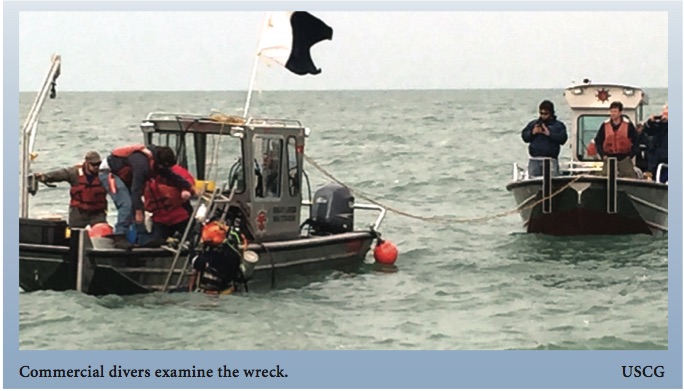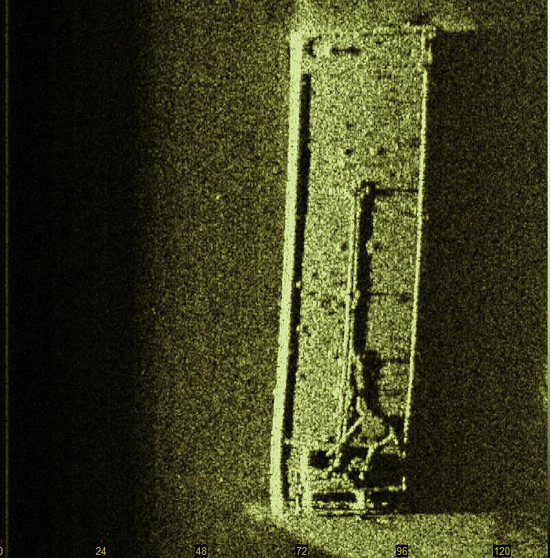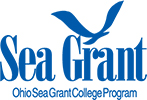Sinking the Argo
by Jim Paskert and Tom Kowalczk
R.M. Spedden Company was started by Captain Robert M. Spedden in the early 1890s on the north shore of the Patapsco River in the Fells Point neighborhood of Baltimore, Maryland. The business was incorporated as Spedden Shipbuilding Company in 1898 and operated under this name through the end of World War II. Located at 1707 Thames Street, in 1911 the yard built and launched the steel-hulled covered lighter Argo, 853 gross tons, official number 164617, for Independent Pier Company of Philadelphia, PA.
Independent Pier Company was founded by Emil Meyle about 1895. The company’s services included wharfage, towing, lighterage, stevedoring and terminal operation. The steady growth of marine traffic in and out of Philadelphia Harbor compelled the company and many others located along Philadelphia’s waterfront on the Delaware and Schuylkill rivers to continuously expand operations to meet the ever increasing demand. The Argo was added to a growing list of vessels owned and operated by Independent Pier Company. At the end of World War 1 the demand for fuel oil and gasoline due to the transition from steam power to diesel power and from horse and buggy to automobiles and trucks necessitated the construction of equipment and facilities to transport and store fuel products. In response to this demand the Argo was converted to a 421 ton tank barge and used to move and store fuels. At the end of the Great Depression in 1932 the Argo was operating in the petroleum transportation business in and around New York Harbor. In 1936 the Argo was sold to W. J. Townsend of Bayonne, NJ who operated a small fleet of tugs and barges in New York Harbor and associated rivers and canals. The Argo was often paired with the large diesel powered steel tug Syosset (Fig. 1) which had been acquired by Townsend from the Long Island Railroad in 1935.
Voyage on the Great Lakes
Near the end of September, 1937 the tug Syosset and barge Argo came up the Erie Canal system to Oswego harbor. At Oswego, Captain Rex Westfall of the Syosset hired William Burke of Oswego to serve as Pilot for the Great Lakes portion of the voyage to Sault Ste. Marie, Canada. Mr. Burke was a licensed Master and Pilot on the Great Lakes for twenty-five years and, since Captain Westfall was only licensed for the waters of New York Harbor, Hudson River, New York State Barge Canals, Niagara River, Black Rock Channel, Buffalo Harbor and Staten Island sound, the services of a licensed Pilot were required. Mr. Burke boarded the Syosset in Oswego on September 30th and piloted the tug and barge up the lakes to Sault Ste. Marie, Canada arriving there on October 10th.
At the Soo the Syosset and Argo docked at Algoma Steel where they would load cargo. Steelmaking had its beginning there in 1901 when American entrepreneur Francis Hector Clergue founded the business. Steady growth allowed the mill to expand. Additional properties were purchased and new coke ovens and blast furnaces based on the latest technological process improvements were constructed. Algoma became a North American pioneer in the basic oxygen steelmaking process. In addition to coke, the new coke ovens produced by-products that were also in demand. In the process of converting coal into coke, the volatile matter in the coal is vaporized and driven off as a gas. This coke oven gas contains contaminants including tar, light oil (a mix of mostly benzene, toluene, and xylene), naphthalene, and ammonia. The light oil recovered as a by- product was called crude light oil and additional refining would produce products that were commercially in demand by other industries and very profitable. The crude light oil could be further refined into such products as benzol, toluol, xylol, etc at the coke oven by-products plant or sold to others for further refining. The barge Argo loaded a cargo of coke oven light oils, by-products of the Algoma Steel coking operation. The cargo consisted of approximately 101,000 gallons of benzol and 106,800 gallons of crude light oil.
Disaster
The tug Syosset with the barge Argo in tow left the Soo on October 12th, 1937 and by October 17th had made their way past Detroit, down the Livingstone Channel and out into Lake Erie. When about seven (7) miles above Colchester Light the wind from the SE freshened and the tug and barge were compelled to turn around and go back to Amherstburg to wait for better weather. On the morning of October 19th, after a two day wait, Capt. Westfall and Capt. Burke decided that the wind had died down sufficiently to allow them to proceed so they set out again. The tug and barge reached Colchester Light about 2:00 PM with the wind light and variable from the SSE and SE and the lake relatively calm. As the tug and barge made their way through the dangerous Pelee Passage the wind and seas increased steadily and, as the Syosset and Argo neared the Southeast Shoal Light at 5:50 PM, Capt. Westfall expressed some concern due to the deteriorating weather. After conferring with Capt. Burke, Capt. Westfall decided to turn into the wind and head SSW toward the east side of Pelee Island hoping to find some relief in the lee of the island. The wind and sea were now about S, sometimes SW and still building. The engine of the tug was checked down and her speed reduced. The tug forged ahead at a slow 2 mph with seas mounting the forward end and throwing spray steadily onto the wheelhouse. Working their way slowly down the east side of Pelee Island, the tug and barge cleared east of Chickenolee Reef with little relief from the heavy seas and 30 to 40 mile per hour winds. Occasionally the tug would fall off in a trough and roll wildly. Meanwhile, the barge, heavy with oil had only 21⁄2 feet of freeboard and a draft of about 101⁄2 feet. The Argo, lying low in the water, was under constant attack from the waves, the seas easily mounting the deck and washing completely over the barge. At about 11:45 PM the captain noticed the lights had gone out on the barge and sent the deckhand back to the stern of the tug to see if he could get a better look. The deckhand reported that the lights were out on the barge but the hawser was OK and the barge was still in tow. At 12:00 midnight the watch changed and the deckhand was relieved. As usual the oncoming deckhand immediately made a check of the tug and towline. Running into the wheelhouse he reported that the barge was in some distress. It didn’t look right. The Captain turned the tug around and, running with the seas under a clearing sky and brightly shining moon, approached the barge. In the moonlight they could see the barge on her side, low by the bow with only a small part of the starboard stern showing above the water and on which the two crewmen of the barge were precariously perched. The captain ordered the hawser dropped from the tug and he maneuvered the tug slowly toward the sinking barge in an attempt to rescue the two bargemen still there. Finally, after several attempts, the crew of the tug managed to throw a line to each of the bargemen and they, after tying the lines around their waists, jumped into the water and were pulled to the side of the tug and hauled aboard. With the bargemen safely on board the Syosset, unable to do anything to save the slowly settling barge in the heavy seas left the Argo to its fate and headed for safety on the South shore of Lake Erie.
The Search
The USCG cutter Tahoma (Fig. 2) left Cleveland on the morning of October 20th to begin a search for the lost barge. Captain Westfall of the Syosset had reported the loss of the Argo early that morning upon arriving in Lorain and orders were sent immediately to the Tahoma instructing the cutter to get underway. Winds and weather were still bad WxS winds blowing 20 – 25 kts. It was still very rough. The crew of the Tahoma could not have been very happy about going out in such conditions – conditions and weather bad enough to compel the cancellation of normal daily drills. Upon arriving in the area where the Argo was last seen, the Tahoma commenced the search running a square pattern with about 20 minute legs working the pattern from west to east. Running at 14.5 mph each 20 minute leg was approximately 4.8 miles in length. The cutter ran south, then east, then north, then east, then south, etc, etc. This continued all afternoon and into the evening until they were back near Cleveland.

Entering Cleveland Harbor the Tahoma turned and ran the length of the inner harbor exiting at the east break wall light where it rounded up to 279°T and ran slow ahead about 3 mph all night. At 8 AM on Thursday, October 21st. the cutter began a north run until near Southeast Shoal Light where it turned east and then south about noon. The weather was hazy with diminishing winds and steady rollers out the southwest. After drills and back near SE Shoal, the Tahoma proceeded southwest probably attempting to follow the reported track of the tug and barge prior to the sinking. About two hours later an oil slick was sighted and the cutter was anchored nearby. A small boat was launched to investigate the slick which hopefully would lead to the sunken barge. This effort proved unsuccessful. The Tahoma remained at anchor at the site all night and in the morning again launched a small boat to investigate further and take soundings. Finding a smooth bottom with no variation in depth, the cutter departed for Cleveland at full speed
On Saturday, October 23, the Southeast Shoal Light reported three barges adrift in the passage. These turned out to be pontoons. The Tahoma responded and located one of them taking it in tow.
For the next several days the Tahoma searched the lake for both the lost “barges” (pontoons) and the Argo. The Tahoma continued searching the lake through Thursday, November 4th.
The Lake Carriers Association sent notices about the lost barge to shipping interests on the Great Lakes. With no further sightings and the shipping season on the lakes coming to an end, the sunken barge Argo was quickly forgotten.
Investigation
Following the disaster, the captain and crew of the tug and barge were interviewed by the Bureau of Marine Inspection & Navigation, Department of Commerce. The investigation board was convened to investigate the loss by foundering of the barge Argo.
Findings of the Board were:
1. The barge Argo was inspected and certified on August 19, 1937 for “bays, sounds and rivers between Sandy Hook, New Jersey, and Boston, Massachusetts, via Long Island Sound and Cape Cod Canal.”
2. The vessel was no certified to operate on the waters of the Great Lakes
3. The vessel sank by the head and rolled to one side evidence that some portion of the vessel opened up forward allowing the forward end of the vessel to fill, causing that end to sink.
4. The pilot did everything possible to protect the barge and save the crew
5. The vessel was not of seaworthy construction for operating on the Great Lakes. It was certificated only for protected waters, and not certificated to operate in open waters on the Great Lakes.
6. The American Bureau of Shipping stated that “no load line assignment nor certification has been made thereto.”
7. The vessel was being operated on the Great Lakes in violation of the Load Line Act.
8. The towing vessel, the tug Syosset, was not responsible for the barge being operated on the Great Lakes without being certificated or complying with the Load Line Act.
On Friday, August 28, 2015, while performing a historical shipwreck side scan sonar search in the waters of Lake Erie, Tom Kowalczk of Cleveland Underwater Explorers (CLUE) detected a target of interest on the otherwise featureless lake bottom east of the Lake Erie islands. Taking advantage of favorable weather and lake conditions and utilizing the capabilities of the electronics aboard his well-equipped vessel, Kowalczk
was able to obtain high resolution, high quality side scan sonar images of what appeared to be a large intact barge sitting upright on the bottom of the lake. Kowalczk was quite confident that he had found the tank barge Argo which had been abandoned in a sinking condition during an autumn gale in the early morning hours of Oct. 20, 1937. The Argo was last seen afloat in this general area and eventually sank.
The first step of CLUE’s standard post-discovery process includes independent reviews of all discovery and available historical data by CLUE members, additional historical research, discussion, and debate. CLUE ultimately concluded that the newly discovered shipwreck was in all probability the tank barge Argo, a shipwreck that the post-discovery process revealed to be 1 of 87 shipwrecks identified by the National Oceanic and Atmospheric Administration (NOAA) in 2013 as a possible threat to the environment. NOAA’s assessment relative to the Argo had compelled the USCG to develop contingency plans for the purpose of determining and mitigating any environmental issue(s) should the Argo ever be found.
CLUE contacted the National Museum of the Great Lakes(NMGL), a sponsor of CLUE’s historical shipwreck endeavors, to advise them of the discovery and discuss the most logical and prudent next steps. CLUE and NMGL recognized that their efforts to locate, investigate, document and preserve our submerged cultural resources must be in concert with and not present a risk to the integrity of the marine environment in which these resources reside. The organizations mutually agreed that any further on or in water activity relative to the Argo would be imprudent and that the only responsible course of action would be to contact the USCG, provide them with details of the discovery and allow them to put their contingency plans in motion.
CLUE subsequently contacted the 9th District USCG who moved quickly to set up a meeting to discuss the discovery and review the evidence supporting the identification of the wreck as the tank barge Argo. Based on the information and documentation provided by CLUE and NMGL at the meeting, the USCG and NOAA concluded that the recently discovered shipwreck was in all probability the tank barge Argo. As the USCG was very well prepared for this circumstance, they immediately commenced the real-time assessment process.

Environmental Threat
On May 20, 2013 the National Oceanic and Atmospheric Administration (NOAA) issued a report examining the threat of oil pollution from shipwrecks scattered across the US. The sunken vessels identified in the report represent the greatest risks of oil pollution based on “Remediation of Underwater Legacy Environmental Threats (RULET). This report was developed in response to Congress providing funds for the agency to specifically address the ecological and socio-economic resources at risk. Initial screening of these shipwrecks provided a list of 573 threats of substantial pollution risks. Additional research narrowed that list to 107 vessels. Finally, prioritization by likelihood of spill, amounts of oil remaining onboard and the potential ecological and environmental effects if that spill occurred were considered and that further reduced the number of wrecks to 87.
The United States Coast Guard is charged with the responsibility for mitigating oil spills in the coastal marine environment. Regional Response Teams and local Area committees are established under the Oil Pollution Act of 1990. The report is not intended to provide direction for the USCG to search and locate these shipwrecks but it provided a scientific and technical assessment for guidance in the case that these shipwrecks would be located or they began leaking. This report was incorporated into the assessments of regional and area response contingency plans.

Based on NOAA’s assessment, the Argo was the greatest potential threat to the Great Lakes.
As a result of the NOAA report recommendation was made that the Argo “be noted in the Area Contingency Plans so that if a mystery spill is reported in the general area, this vessel could be investigated as a source
Contingency
A JRT (Joint Response Team) meeting was held on May 14/15, 2014 that specifically addressed the possibility of a catastrophic release of oil from the sunken barge Argo. The JRT membership is comprised of USCG, Canadian CG and Transport Canada Marine Safety. The main focus of this team consists of establishing the proper response to varies impact areas, new and revised enhanced notification precedures and logistics of the responding teams. The contingency plan relative to the Argo was formulated and a simulated deployment exercise was performed in September, 2014. This preparation made initiation of the actual activities, put into play shortly after CLUE contacted the USCG concerning the
sunken barge, more timely and efficient.
Epilogue
CLUE would like to express our appreciation for the consideration, cooperation and very timely attention extended to us by the USCG. In addition, as citizens and taxpayers we were very pleased to learn that agencies of our federal government, the NOAA and the USCG in particular, are proactively working to safeguard the waters of the Great Lakes and its natural resources.
Sources
Records of the United States Coast Guard, “United States Coast Guard Casualty and Wreck Report”, barge Argo
United States Coast Guard, log of the CGC Tahoma
Ottawa County News, Port Clinton, Ohio, October 22, 1937
Department of Commerce and Labor, Bureau of Navigation. “Merchant Vessels of the United States”, 1912 through 1937
Department of Commerce, National Oceanic and Atmospheric Administration, “Risk Assessment for Potentially Polluting Wrecks in U.S. Waters”
The Evening News, Sault Ste. Marie, Michigan, February 10, 1938
Department of Commerce, National Oceanic and Atmospheric Administration,
“Screening Level Risk Assessment Package Argo”
ThyssenKrupp EnCoke USA, Mike Platts, “The Coke Oven By-Product Plant”
Minutes, JRT Meeting, May 14/15, 2014
Letter, January 31, 1938, R.S. Field, Director, Bureau of Marine Inspection and Navigation
Letter, January 6, 1938, “B” Marine Investigation Board
Department of Commerce, Bureau of Marine Inspection and Navigation. “Proceeding, Transactions, and Testimony before a U.S. “B” Marine Investigation Board”.
Letter, October 21, 1937, Capt. R.E. Westfall, Master Tug Syosset
Department of Commerce, Bureau of Navigation and Steamboat Inspection,
Certificate of Inspection, Barge Argo.
Department of Commerce, Bureau of Marine Inspection and Navigation, Casualty
Report, tug Syosset.
Department of Commerce, Bureau of Marine Inspection and Navigation. “Testimony in the matter of the Loss of the Barge Argo” before a U.S. “C” Marine Investigation Board”.
Pacific Marine Review, March, 1938
Independence Seaport Museum, Independent Pier Company records, 1909-1980










